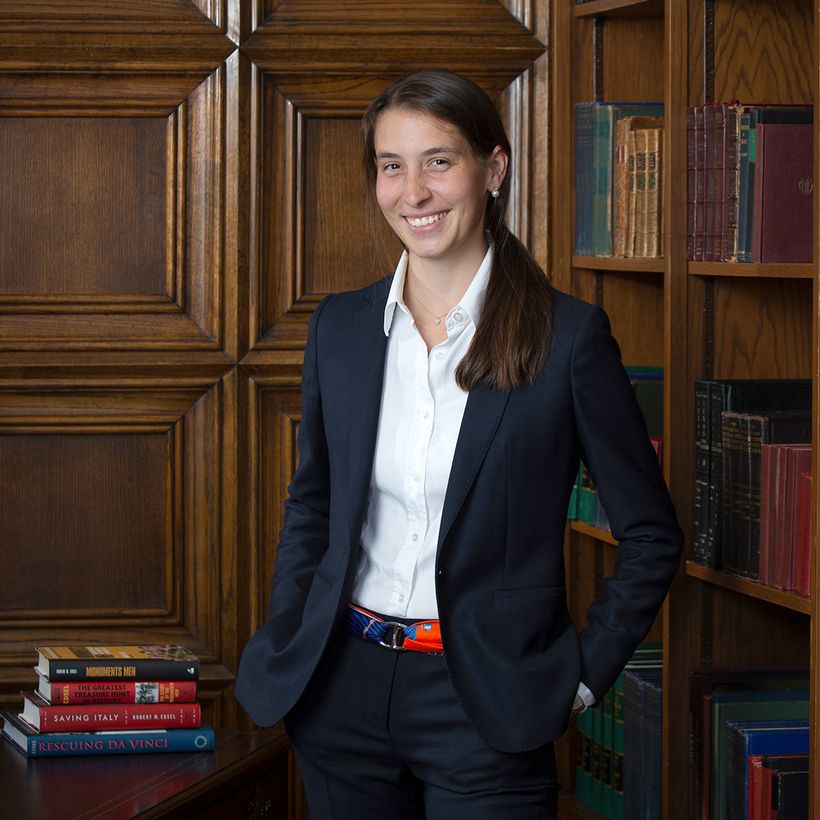Anna Bottinelli is an altruistic sleuth—an art detective who tracks down Nazi-stolen works, proving their provenance before re-uniting them with their rightful owners. She also happens to look like she stepped out of a fashion advertisement and speaks with a thick Italian accent, undercut with the subtlest of Texas twangs.
Raised in Florence, Bottinelli studied art history in both Rome and London before beginning her career as the lead Italian researcher for Robert M. Edsel, an oilman turned author who went on to write The Monuments Men: Allied Heroes, Nazi Thieves and the Greatest Treasure Hunt in History, which went on to become a film. He also married Bottinelli. (More on that in a bit.)

She secured herself a permanent job after she nailed her very first assignment—determining whether a German bombing of Milan in August 1943 had specifically targeted invaluable artworks, including Leonardo da Vinci’s The Last Supper, which was nearly destroyed. Bottinelli’s task was to investigate whether the sky had been pitch-black, which would suggest advance planning, or moonlit, which could imply that the bombings were random. She spent weeks in archives deciphering conflicting reports before contacting nasa to discover that there had been a partial lunar eclipse that night.
After four years of professional collaboration, Bottinelli and Edsel fell in love and were later married. Now they live in Dallas with their two children and collaborate on hunting Nazi-stolen art all over the world through their nonprofit organization, the Monuments Men and Women Foundation. In 2019, Bottinelli was appointed its new president, succeeding her husband, who is now its chairman.
No fees are charged to clients. “We believe in doing the right thing,” says Bottinelli. Missing works—many of high value and historical significance—tend to surface at auctions or in attics after an elderly family member passes away. “Offspring tend to have a different approach, often with more of a social conscience, when it comes to returning items to their rightful owners,” she says. But when investigations do take a criminal turn, Bottinelli and her team hand things over to lawyers or the F.B.I., with whom they often collaborate.
Even after decades of discovery, there are still more than 100,000 works of art that are considered missing after being stolen from Jewish families and institutions during World War II. Bottinelli is working on tracking down two in particular.
Raphael’s Portrait of a Young Man is the most significant. “The world would stop breathing if there was news of its recovery,” says Bottinelli. It belongs to the Princes Czartoryski Museum in Kraków, and it had always been displayed alongside two other masterpieces, da Vinci’s Lady with an Ermine and Rembrandt van Rijn’s Landscape with the Good Samaritan. The three paintings were stolen at the same time, but only the Leonardo and the Rembrandt were recovered by the Monuments Men and Women Foundation.
For the first time, a reward of up to $25,000 is being offered for information leading to the recovery of each cultural object, including the Raphael, portrayed in the foundation’s WWII Most Wanted Art deck of playing cards. “We don’t usually get the public involved in a hunt, but this year we created a deck of playing cards showing the masters still missing,” says Bottinelli. “The Raphael is on the cover.”

The second work she is focused on is Edgar Degas’s Portrait of Mlle. Gabrielle Diot. “We know it’s in somebody’s private collection,” she says. The pastel showed up most recently in 1987, when it was offered for sale at a Hamburg gallery. The family laying claim to the work called the gallery owner, Mathias Hans, but he cited confidentiality rules preventing him from disclosing who possessed it. The lead went dead, where it remains today.
But at least a few discoveries happen almost effortlessly. In 2013, after a 96-year-old American veteran named Irving Tross heard about the work of the Monuments Men, his daughter called the foundation with a tip. When her father was stationed in Italy during the war, she explained, he found eight books outside a church in the countryside. He took them into his possession so they wouldn’t be destroyed by the elements. Over the years, he mentioned to his grandson that the books belonged elsewhere, but his offers to find their home were dismissed.
Bottinelli discovered that the books were priceless manuscripts belonging to the University of Naples; one of them was an Italian translation of Isaac Newton’s Opticks. Bottinelli orchestrated the return of the books to the university, and although Tross was infirm, his grandson handed over the books during a ceremony at the Pritzker Military Library, in Chicago.
Tross died two months later, when the manuscripts were finally back where they belonged. Meanwhile, Bottinelli’s work continues, in hopes of generating more stories like his.
Louise Roe is a London-based broadcast journalist and writer, and the founder of Sharland England, a collection of furnishings and home goods

